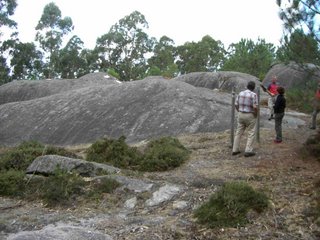Rock art and archaeoastronomy?



Pepe Galovart keeps sending images (some from Monique Larrey) and suggestions from Galicia. In this case, the petrogliphs of Auga da Laxe, 5 Km from Vigo.This carvings lay in a flat area, with the Monte Galiñeiro to the East. Note that the shape of this hill recalls the one of Monsaraz and others in Central Alentejo (see post from 11.08.2006). It is possible that Monte Galiñeiro was used as a back-sight, from Auga da Laxe, to observe the Spring Full Moon. The same observation could eventually be made about the petrogliphs of Muros, all facing eastwards (see post from 03.12.2006).
Another interesting remark about the petrogliphs of Muros is the horse-shoe shape of the landscape framing the carved rocks. A similar patern has been observed in the important megalithic sites of Barrocal, Xarez or Almendres (Central Alentejo), as well as in the Quiberon Bay (Morbihan, Brittany) where the most outstanding megalithic sites of the world are placed (the Carnac alignments or the Locmariaquer menhir).
Finally, a coment about the quern stones made on the bedrock (like a form of rock art).
They made me think about the relatioship between rock art and mills (see the post of 14.09.2006).
I only know, in Portugal, a similar example of quern stones, virtually unpublished: the granite rock shelter of Toca da Galiana, on the left bank of the Guadiana river, just in front of the Chalcolithic settlement of Sala nº 1 (Pedrógão, Vidigueira).


Comments